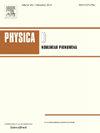具有异构传输延迟的非线性群体迁移模型的柔性演化
IF 2.9
3区 数学
Q1 MATHEMATICS, APPLIED
引用次数: 0
摘要
动物群体的分工合作是群体智能的外在表现,如动物集体迁徙中的领导者和追随者。本文提出了一种非线性多智能体系统的集体迁移模型,并试图建立一个更真实的动态领导者-追随者结构,以促进群体跟踪的灵活进化。该模型突出了个体异质性,特别是包括代理之间的异构传输延迟和称为跟踪策略的异构参数,这些参数在每个代理的校准和跟踪之间建立了权衡,并从本质上确定了系统的领导-追随者结构。通过构造动态速度上界、设置跟踪周期和划分状态空间,设计时变跟踪策略向量,生成具有灵活配置的动态leader-follower结构,使系统在任意初始状态下都能实现集群跟踪。传输时延的增大延长了导从动结构的切换周期,降低了系统的收敛速度。给出了跟踪策略向量的一种算法和几个数值仿真来验证我们的结果。本文章由计算机程序翻译,如有差异,请以英文原文为准。
Flexible evolution of flocking tracking for a nonlinear collective migration model with heterogeneous transmission delays
Division of labour and cooperation in animal groups is an external manifestation of swarm intelligence, such as leaders and followers in collective migration of animals. In this paper, we propose a nonlinear multi-agent system named collective migration model and try to build a more realistic dynamic leader–follower structure that facilitates flexible evolution of flocking tracking. The model highlights individual heterogeneity, especially including heterogeneous transmission delays among agents and heterogeneous parameters called tracking strategies that establish a trade-off between alignment and tracking for each agent, and essentially determine the leader–follower structure of the system. By constructing dynamic upper bounds of velocity, setting tracking periods and partitioning state space, a time-varying tracking strategy vector is designed to produce a dynamic leader–follower structure in which the system has a flexible configuration and can achieve flocking tracking for any initial state. The increase of transmission delay prolongs the switching cycle of leader–follower structure, and decreases the convergence speed of the system. An algorithm of the tracking strategy vector and several numerical simulations are provided to verify our results.
求助全文
通过发布文献求助,成功后即可免费获取论文全文。
去求助
来源期刊

Physica D: Nonlinear Phenomena
物理-物理:数学物理
CiteScore
7.30
自引率
7.50%
发文量
213
审稿时长
65 days
期刊介绍:
Physica D (Nonlinear Phenomena) publishes research and review articles reporting on experimental and theoretical works, techniques and ideas that advance the understanding of nonlinear phenomena. Topics encompass wave motion in physical, chemical and biological systems; physical or biological phenomena governed by nonlinear field equations, including hydrodynamics and turbulence; pattern formation and cooperative phenomena; instability, bifurcations, chaos, and space-time disorder; integrable/Hamiltonian systems; asymptotic analysis and, more generally, mathematical methods for nonlinear systems.
 求助内容:
求助内容: 应助结果提醒方式:
应助结果提醒方式:


